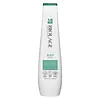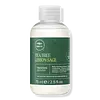What's inside
What's inside
 Key Ingredients
Key Ingredients

 Benefits
Benefits

 Concerns
Concerns

 Ingredients Side-by-side
Ingredients Side-by-side

Water
Skin ConditioningSodium Laureth Sulfate
CleansingCitric Acid
BufferingCocamidopropyl Betaine
CleansingSodium Hydroxide
BufferingSodium Chloride
MaskingParfum
MaskingSodium Benzoate
MaskingGlycine
BufferingHexylene Glycol
EmulsifyingGlycolic Acid
BufferingPropylene Glycol
HumectantSalicylic Acid
MaskingMenthol
MaskingPolyquaternium-10
Limonene
PerfumingSaccharomyces/Xylinum/Black Tea Ferment
Skin ConditioningHexyl Cinnamal
PerfumingCoumarin
PerfumingBenzyl Alcohol
PerfumingLinalool
PerfumingGlycerin
HumectantAmyl Cinnamal
PerfumingSorbitol
HumectantCamellia Sinensis Leaf Extract
AntimicrobialPotassium Sorbate
PreservativeAscorbic Acid
AntioxidantWater, Sodium Laureth Sulfate, Citric Acid, Cocamidopropyl Betaine, Sodium Hydroxide, Sodium Chloride, Parfum, Sodium Benzoate, Glycine, Hexylene Glycol, Glycolic Acid, Propylene Glycol, Salicylic Acid, Menthol, Polyquaternium-10, Limonene, Saccharomyces/Xylinum/Black Tea Ferment, Hexyl Cinnamal, Coumarin, Benzyl Alcohol, Linalool, Glycerin, Amyl Cinnamal, Sorbitol, Camellia Sinensis Leaf Extract, Potassium Sorbate, Ascorbic Acid
Water
Skin ConditioningSodium C14-16 Olefin Sulfonate
CleansingSodium Lauryl Sulfate
CleansingCocamidopropyl Hydroxysultaine
CleansingCocamide Mipa
EmulsifyingMelaleuca Alternifolia Leaf Water
AntimicrobialCitrus Limon Fruit Extract
MaskingSalvia Officinalis Extract
AntimicrobialPanthenol
Skin ConditioningSodium Chloride
MaskingPanthenyl Ethyl Ether
Magnesium Nitrate
Glycerin
HumectantCitric Acid
BufferingSodium Hydroxide
BufferingPolyquaternium-10
Disodium EDTA
Magnesium Chloride
Tetrasodium EDTA
Methylchloroisothiazolinone
PreservativeMethylisothiazolinone
PreservativeParfum
MaskingTetramethyl Acetyloctahydronaphthalenes
MaskingHexyl Cinnamal
PerfumingLimonene
PerfumingLinalool
PerfumingCitrus Limon Peel Oil
MaskingWater, Sodium C14-16 Olefin Sulfonate, Sodium Lauryl Sulfate, Cocamidopropyl Hydroxysultaine, Cocamide Mipa, Melaleuca Alternifolia Leaf Water, Citrus Limon Fruit Extract, Salvia Officinalis Extract, Panthenol, Sodium Chloride, Panthenyl Ethyl Ether, Magnesium Nitrate, Glycerin, Citric Acid, Sodium Hydroxide, Polyquaternium-10, Disodium EDTA, Magnesium Chloride, Tetrasodium EDTA, Methylchloroisothiazolinone, Methylisothiazolinone, Parfum, Tetramethyl Acetyloctahydronaphthalenes, Hexyl Cinnamal, Limonene, Linalool, Citrus Limon Peel Oil
 Reviews
Reviews

Ingredients Explained
These ingredients are found in both products.
Ingredients higher up in an ingredient list are typically present in a larger amount.
Citric Acid is an alpha hydroxy acid (AHA) naturally found in citrus fruits like oranges, lemons, and limes.
Like other AHAs, citric acid can exfoliate skin by breaking down the bonds that hold dead skin cells together. This helps reveal smoother and brighter skin underneath.
However, this exfoliating effect only happens at high concentrations (20%) which can be hard to find in cosmetic products.
Due to this, citric acid is usually included in small amounts as a pH adjuster. This helps keep products slightly more acidic and compatible with skin's natural pH.
In skincare formulas, citric acid can:
While it can provide some skin benefits, research shows lactic acid and glycolic acid are generally more effective and less irritating exfoliants.
Most citric acid used in skincare today is made by fermenting sugars (usually from molasses). This synthetic version is identical to the natural citrus form but easier to stabilize and use in formulations.
Read more about some other popular AHA's here:
Learn more about Citric AcidGlycerin is already naturally found in your skin. It helps moisturize and protect your skin.
A study from 2016 found glycerin to be more effective as a humectant than AHAs and hyaluronic acid.
As a humectant, it helps the skin stay hydrated by pulling moisture to your skin. The low molecular weight of glycerin allows it to pull moisture into the deeper layers of your skin.
Hydrated skin improves your skin barrier; Your skin barrier helps protect against irritants and bacteria.
Glycerin has also been found to have antimicrobial and antiviral properties. Due to these properties, glycerin is often used in wound and burn treatments.
In cosmetics, glycerin is usually derived from plants such as soybean or palm. However, it can also be sourced from animals, such as tallow or animal fat.
This ingredient is organic, colorless, odorless, and non-toxic.
Glycerin is the name for this ingredient in American English. British English uses Glycerol/Glycerine.
Learn more about GlycerinHexyl Cinnamal is a fragrance ingredient with a similar scent to jasmine. It can be naturally found in chamomile essential oil.
This ingredient is a known EU allergen and may sensitize the skin. The EU requires this ingredient to be listed separately on an ingredients list.
Hexyl Cinnamal is not water soluble but is soluble in oils.
Learn more about Hexyl CinnamalLimonene is a fragrance that adds scent and taste to a formulation.
It's found in the peel oil of citrus fruits and other plants such as lavender and eucalyptus. The scent of limonene is generally described as "sweet citrus".
Limonene acts as an antioxidant, meaning it helps neutralize free radicals.
When exposed to air, oxidized limonene may sensitize the skin. Because of this, limonene is often avoided by people with sensitive skin.
The term 'fragrance' is not regulated in many countries. In many cases, it is up to the brand to define this term. For instance, many brands choose to label themselves as "fragrance-free" because they are not using synthetic fragrances. However, their products may still contain ingredients such as essential oils that are considered a fragrance.
Learn more about LimoneneLinalool is a fragrance and helps add scent to products. It's derived from common plants such as cinnamon, mint, citrus, and lavender.
Like Limonene, this ingredient oxidizes when exposed to air. Oxidized linalool can cause allergies and skin sensitivity.
This ingredient has a scent that is floral, spicy tropical, and citrus-like.
Learn more about LinaloolParfum is a catch-all term for an ingredient or more that is used to give a scent to products.
Also called "fragrance", this ingredient can be a blend of hundreds of chemicals or plant oils. This means every product with "fragrance" or "parfum" in the ingredients list is a different mixture.
For instance, Habanolide is a proprietary trade name for a specific aroma chemical. When used as a fragrance ingredient in cosmetics, most aroma chemicals fall under the broad labeling category of “FRAGRANCE” or “PARFUM” according to EU and US regulations.
The term 'parfum' or 'fragrance' is not regulated in many countries. In many cases, it is up to the brand to define this term.
For instance, many brands choose to label themselves as "fragrance-free" because they are not using synthetic fragrances. However, their products may still contain ingredients such as essential oils that are considered a fragrance by INCI standards.
One example is Calendula flower extract. Calendula is an essential oil that still imparts a scent or 'fragrance'.
Depending on the blend, the ingredients in the mixture can cause allergies and sensitivities on the skin. Some ingredients that are known EU allergens include linalool and citronellol.
Parfum can also be used to mask or cover an unpleasant scent.
The bottom line is: not all fragrances/parfum/ingredients are created equally. If you are worried about fragrances, we recommend taking a closer look at an ingredient. And of course, we always recommend speaking with a professional.
Learn more about ParfumPolyquaternium-10 is an ammonium salt of hydroxyethylcellulose. It is a white and granular powder used as a film-former and anti-static agent.
This ingredient is commonly found in hair conditioning products. According to a manufacturer, its positive charge makes it great for absorbing hair proteins. The manufacturer also states this ingredient helps with curl retention.
For haircare friends: this ingredient is not a silicone.
Learn more about Polyquaternium-10Chances are, you eat sodium chloride every day. Sodium Chloride is also known as table salt.
This ingredient has many purposes in skincare: thickener, emulsifier, and exfoliator.
You'll most likely find this ingredient in cleansers where it is used to create a gel-like texture. As an emulsifier, it also prevents ingredients from separating.
There is much debate on whether this ingredient is comedogenic. The short answer - comedogenic ratings don't tell the whole story. Learn more about comegodenic ratings here.
The concensus about this ingredient causing acne seems to be divided. Research is needed to understand if this ingredient does cause acne.
Scrubs may use salt as the primary exfoliating ingredient.
Learn more about Sodium ChlorideSodium Hydroxide is also known as lye or caustic soda. It is used to adjust the pH of products; many ingredients require a specific pH to be effective.
In small amounts, sodium hydroxide is considered safe to use. However, large amounts may cause chemical burns due to its high alkaline.
Your skin has a natural pH and acid mantle. This acid mantle helps prevent harmful bacteria from breaking through. The acid mantle also helps keep your skin hydrated.
"Alkaline" refers to a high pH level. A low pH level would be considered acidic.
Learn more about Sodium HydroxideWater. It's the most common cosmetic ingredient of all. You'll usually see it at the top of ingredient lists, meaning that it makes up the largest part of the product.
So why is it so popular? Water most often acts as a solvent - this means that it helps dissolve other ingredients into the formulation.
You'll also recognize water as that liquid we all need to stay alive. If you see this, drink a glass of water. Stay hydrated!
Learn more about Water